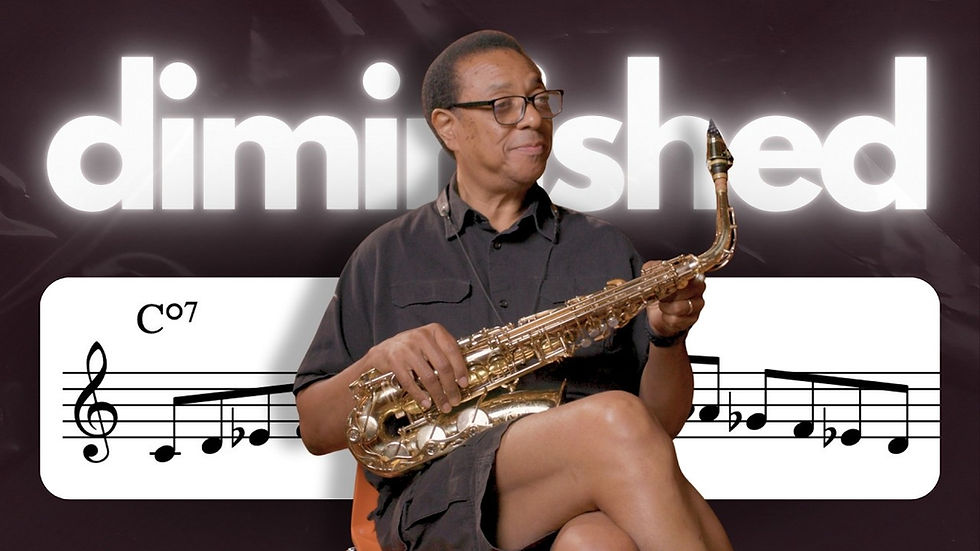How to Make a Transcribed Line Your Own
- Jazz Lesson Videos

- Aug 8
- 3 min read
We all know that transcription is helpful as a jazz musician, but have you ever wished that you had something that was your own after all that work? Well today, we’re going to run through a method to do just that — we’ll be looking at how you can take a transcribed line and while keeping all the color and harmonic vibe, make it your own.
This technique comes from Nathan’s course with Jazz Lesson Videos titled “Application of Jazz Vocabulary.” And if you want to see how Nathan plays through this exercise himself, be sure to check out our accompanying YouTube video “How to Make a Transcribed Line Your Own”.

Now let’s get playing!
So what we’re going to do is rewrite a line from a different starting point, and make your line contain the elements needed to still feel like that line, all while technically being yours. Let’s take a look at one of the more sophisticated lines from Sonny Stitt’s solo on “Sunny side of the Street.” You can find this one in measure 17.


From there, let’s grab some staff paper and see if we can replicate this line from a different starting point.
Now starting from Em7, we had the following.

We started on the root, then played down to the chromatic approach tone, back to the root, and then we walked up to the third. We’re going to start this line on the third and see if we can replicate everything from here.
We’ll play the third, and we're going to go down a chromatic approach tone, return, and then walk up to another chord tone.
Going back to the original line, we had a three-note enclosure around the root, so we’re going to make a three-note enclosure around our b3.

Great! Let's keep going.
This line encloses the third of the V, so we’re enclosing the 3 of A7. So can we enclose the V of A7 this time?
The original line had two notes from above, two notes from below. So let's do that here.

We’ve got a good thing going so far! Now the next phrase we just go up the scale. So what happens if we do that? If we play a scale running from our E here, it’s nice, but when we arrive at the V chord, our original phrase lands on a chord tone, and we don’t do that here. We landed on a 9. So can we maybe add in a passing tone somewhere so we can land on a chord tone?
Sure enough, if we just add a major seventh passing tone, it sounds great. Now we have a complete measure, and the original line did this.

So we went up three scale tones, and then we went up two diatonic thirds. What would happen if we did it from here?
Now the phrase does this.

Right here, we should land on a C# somehow.

Like this note is one chord tone below the last one. So let's see if we can arrive in that same way. Right now, our line starts on the root. So can we make it down to the 3 somehow? Let's see if we can.

There it is. We just have to go down the scale and it's all there.
From here, we can keep moving until we get to our final product. Let’s take a look at it with the original line side by side.


Cool! We have some slightly different colors, but all of the elements are still there.
Well we hope you enjoyed this technique, but remember, it’s only as good as trying it out yourself! And if you want to dive even deeper on topics like this, make sure to check out Nathan’s course with JLV, “Application of Jazz Vocabulary” and if you want to see how Nathan plays through this technique, be sure to check out our accompanying YouTube video “How to Make a Transcribed Line Your Own.”
So go find a line you like and make it your own! We’ll see you next time!



I still remember the night I first discovered casino vavada online, and it was nothing I had planned. It was one of those evenings when the day had been so long and draining that I didn’t even have the energy to watch TV. I sat there with a cup of tea, scrolling through my laptop, trying to distract myself from the stress of work and the endless list of small daily problems. That’s when I saw someone in a forum talking about how they had found a place online that felt like a mix of excitement, relaxation, and escape all in one. They described it like it wasn’t just a platform, but more like a little corner of the internet…